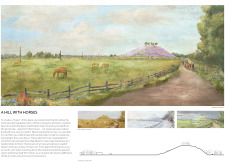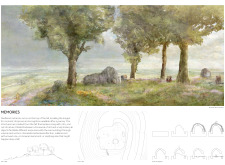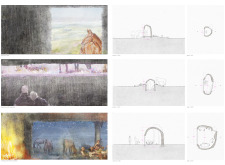5 key facts about this project
Unique Design Approaches
A defining characteristic of this project is its commitment to sustainability and ecological integration. The primary material—native soil—underscores the project’s connection to the landscape, illustrating a thoughtful approach to site-specific design. The use of scrap timber for structural elements minimizes waste and promotes resource efficiency. The design invites visitors to experience the site through various sensory interactions, encouraging an appreciation of local ecology and biodiversity.
The topology of the hill features a gentle incline of 1:25, making it accessible to visitors of all ages and abilities. This consideration for inclusivity is a notable differentiation from typical architectural projects found in similar settings. Moreover, the incorporation of native wildflowers enhances not only the aesthetic quality of the site but also contributes to the local ecosystem, supporting pollinator populations and showcasing the importance of native biodiversity.
Functional Elements and Architectural Details
Central to the design is the pathway leading up to the hill, which is lined with native flora, integrating the landscape with the architectural structure. This pathway serves as both a functional and experiential element, guiding visitors through the landscape and heightening their interaction with the environment. Alongside the path, sheltered seating areas are strategically positioned, providing spaces for rest and social engagement. These communal areas foster connections among visitors and promote an atmosphere of inclusion.
The project exemplifies an enlightened approach to landscape architecture, where built forms coexist with natural elements. By avoiding rigid geometric forms, the design maintains a harmonious relationship with its surroundings. This organic form encourages exploration and instills a sense of tranquility, setting this project apart from conventional architectural designs that often prioritize stark, artificial elements over ecological sensitivity.
In summary, "A Hill with Horses" represents a thoughtful synthesis of architecture and landscape. Its unique approach emphasizes sustainability, community interaction, and sensory engagement with nature. For a comprehensive understanding of this project, including architectural plans, architectural sections, and detailed architectural designs, readers are encouraged to explore the full project presentation.


























